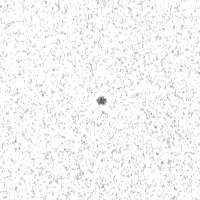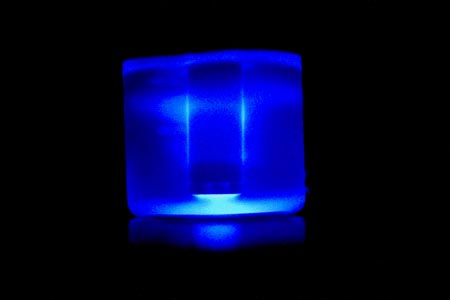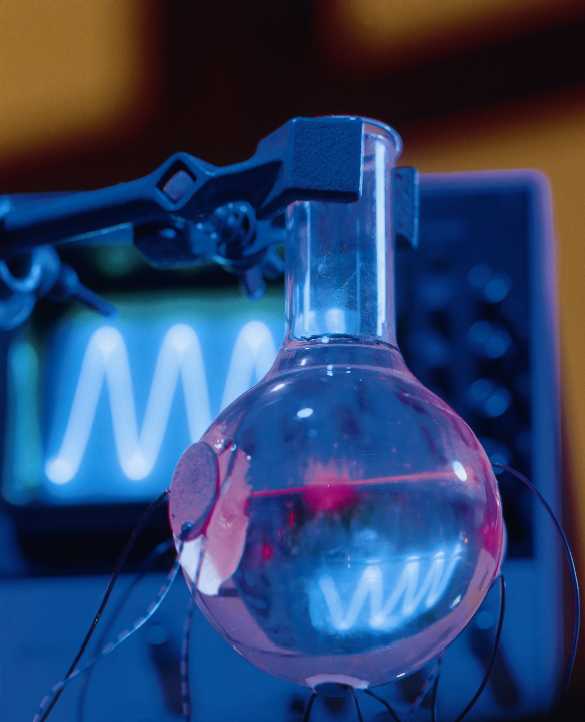Applications of Sonochemistry(SC)
|
Sonoluminescence Single Bubble Sonoluminescence (SBSL) is the emission of flashes of light by imploding air bubbles in liquid. It was first observed as random flashes of light during studies of cavitation. Recently, repetitive emission of SL has been produced under relatively stable, reproducible experimental conditions. The excellent stability of SL from single acoustically levitated bubbles has made possible detailed studies of the emission characteristics[2]. However, since each flash emits only about one million photons, these measurements have generally required averaging the characteristics over a large number of flashes. |
Fig6 - apparatus for single bubble sonoluminescence. The ultrasound is applied across the rounded bottom flask and hence bubble is created. |
|||||
|
Other applications |
||||||
|
In single bubble sonoluminescence, the bubble is concentrating the energy of the acoustic vibrations be a factor of one trillion. The flashes are so brief that to measure the properties of light , we must use photodetectors that respond more quickly than those employed by high-energy physicists. And this is the only means of generating picosecond flashes of light that does not require expensive lasers, which might lead to development of nuclear fusion due to its achievement in focusing of energy. |
||||||

Fig7 - blast of light from single bubble luminescence |
This phenomena is not new, in 1920s and 1930s, chemists working with loudspeakers developed for sonar systems during world war I came across that a strong sound field could catalyze reactions that take place in an aqueous solution. A German scientist, Reinhard Mecke of the University of Heidelberg, stated that the amount of energy needed for a chemical reaction is the same as that needed to excite the emission of light from an atom. So he suggested a search such a signal. Soon afterward, in 1934, H. Frenzel and H.Schultes of the University of Cologne discovered sonoluminescence in a bath of water excited by acoustic waves.[1]. In 1990, Gaitan and Crum showed that a single air bubble can levitate in a standing acoustiv wave setup in sufficiently degassed water until light is emitted when acoustic stress is increased and this is called single bubble sonoluminescene(SBSL), which bring attention to many researchers across the world[15]. |
|||||
|
The mechanisms that convert sound into light still remain unexplained despite many various theoretical approaches. A gas bubble is created into a flask filled with fluid. For example degassed, purified water and air are an excellent pair for the phenomenon. A coherent beam of ultrasound makes the bubble cavitate, i.e. to expand and compress in phase with the sound wave. Typical frequency for the sound wave is 25 kHz.[3] and flashes, which comprise over 105 photons, is genrated and has energy of about 3eV. Furthermore, these burst can occur in a continuously repeating ad has greater [pwer than 1.0 mW within duration of less han 100ps, which is about 100 times faster compared to the fastest visible transition (3 --> 2) in the hydrogen atom.[6]. Also the amount of light emitted with each flash is related to the temperature drops, and this is known as bubble temperature sensitivity.[5] [1] |
||||||
| The apparatus can be easily set up using piezo electric transducer – used in alternating fields of compression and compression-on the top a cylindral flask filled with water. Submerged in the water is a small piece of toaster wire, which boil the water and cause a bubble filled with water vapor forms. Before the vapor recondensed, air dissolved in the water flows into the pocket to create an air bubble. This bubble is then trapped at the centre of the cylindral flask annd monitored its motion using laser[18]. However many more set ups have been developed during a few year and more complicated apparatus are used. | ||||||
|
Fig8 - show the set up of apparatus for single bubble sonoluminescence |
||||||
| Although the mechanism of single bubble sonoluminescense is difficult to explain, the sensvity to temperature suggested that we could learn more about it. One interesting idea is replacing the air bubble with other gas such as nitrogen , noble gas etc.. Surprisingly the pure nitrogen and pure oxygen[16] gas hardly produced any light. By increasing noble gas content of a bubble can dramatically stabilizes the bubble motion and increases the light emission[8][14] | ||||||
| The most rational picture of sonoluminescence involves the creation of a "cold" dense plasma by an imploding shock wave, neither the imploding shock nor the plasma has been directly observed[17]. However, in 1995 Lepoint shows that single argon bubble oscillating nonlinearly in an acoustic field give plasma developed inside the argon bubble and is assumed to be in local thermodynamic equilibrium[8][12] and this might lead to application such as nuclear fusion(sonofusion). | ||||||
| The conditions within the bubble during the last stages of the nearly catastrophic implosion are thought to parallel the efforts aimed at developing inertial confinement fusion. A limited review on the topic of SL and its possible connection to bubble nuclear fusion is presented here. The emphasis is on looking for a link between the various forms of SL observed and the severity of bubble collapse or implosion. A simple energy analysis is also presented to enable the search for an appropriate parameter space and an experimental technique for achieving energy densities required for triggering fusion reactions within the bubble.[13] | ||||||
| Sonoluminescence is not only achived in gas bubbles. Some solutions and compounds, forexample solutions of sulfuric acid and sulfur dioxide enhances give the SL spectra which its intensity decrease with an increase in concentration of the solution, Excited SO2 molecules formed in sulfuric acid due to sonolysis are luminescence emitters. The proposed mechanism of bright SL in these systems is based on the energy transfer from the electron-excited sonolysis products to the SO2 molecules in cavitation bubbles.[9]. In salts (TbCl3, Tb(NO3)(3), PrCl3, EuCl3, CeCl3, and DyCl3), the SL spectrum and intensity of multi-bubble sonoluminescence (SL) of water was observed at a frequency of 20 kHz[10]. Furthermore some organic compounds or polymer were also discovered. [11] | ||||||
| Sonoluminescense also happen in many bubbles system, which response to high frequency and be far more complicated[12]. However, the future is clear about application and popularity among scientist with more publications nowadays and surely this nature’s most nonlinear system might become a source of light in our daily light one day. |
 |
|||||
| Fig9 - Sonoluminescence from a high intensity ultrasonic horn | ||||||
Pictures from:
www.scs.uiuc.edu/ suslick/execsummsono.html
www-phys.llnl.gov/ V_Div/SERS/SL2.html
www.tn.utwente.nl/.../ sonoluminescence.html


